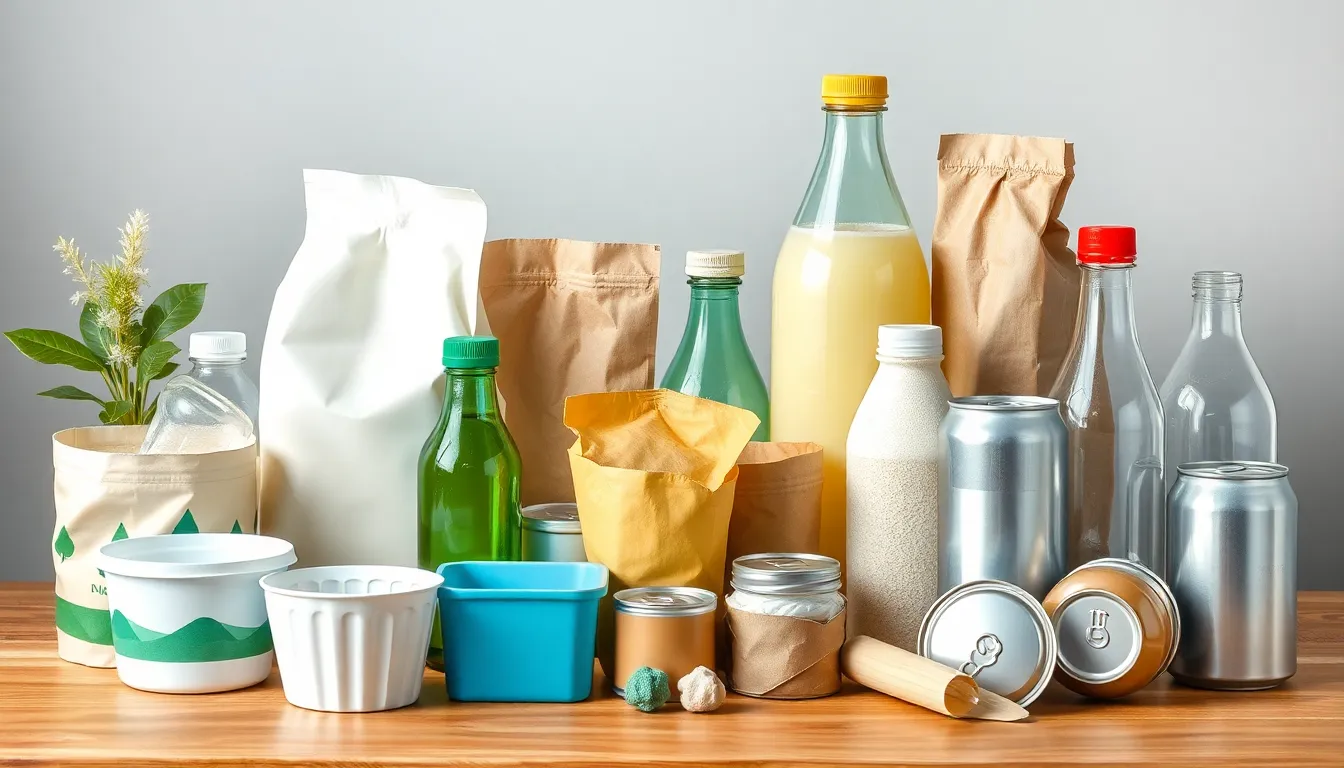In a world drowning in plastic, sustainable packaging technology emerges like a superhero in a green cape, ready to save the planet one box at a time. As consumers become more eco-conscious, brands are scrambling to swap their bubble wrap for biodegradable alternatives. Who knew that saving the Earth could also mean ditching the cringe-worthy guilt of single-use plastics?
Sustainable packaging isn’t just a trend; it’s a revolution. With innovations that make Mother Nature proud, companies are finding clever ways to protect products without harming the environment. From edible wrappers to compostable containers, the future of packaging looks brighter than ever. So buckle up as we explore how these green solutions are reshaping industries and giving waste a run for its money.
Table of Contents
ToggleOverview of Sustainable Packaging Technology
Sustainable packaging technology encompasses a variety of innovative materials and practices designed to reduce environmental impact. This technology focuses on using renewable resources, minimizing waste, and enhancing recyclability. For instance, bioplastics made from plant-based materials serve as alternatives to conventional petroleum-based plastics. They offer similar functionality while lowering carbon footprints.
Adoption of sustainable packaging is driven by regulations aimed at reducing plastic waste and responding to consumer preferences for eco-friendly products. Companies increasingly utilize methods such as minimal packaging designs that reduce material consumption and waste. Examples include lightweight containers and refillable systems that encourage reuse.
Many brands turn to circular economy principles, where materials are designed for continuous use. This strategy ensures that packaging can be recycled, remade, or repurposed, reducing landfill contributions. Technologies like smart packaging also play a role, using sensors to monitor product freshness and optimize supply chains, which leads to less waste generation.
Innovators are developing edible packaging, which provides a unique solution by creating products that can be consumed along with their contents. Compostable materials, such as mushroom-based packaging, break down naturally, enriching soil rather than polluting it.
Collaboration among companies, consumers, and policymakers drives the growth of sustainable packaging technology. Shared goals focus on environmental preservation, leading to advancements in materials, processes, and regulations that promote sustainability. The continued evolution of these technologies indicates a robust movement toward reducing pollution and conserving resources.
Types of Sustainable Packaging

Sustainable packaging includes various innovative materials designed to reduce environmental impact. Two key types of sustainable packaging are biodegradable materials and recyclable materials.
Biodegradable Materials
Biodegradable materials break down naturally over time, reducing landfill waste. These materials decompose into non-toxic components when exposed to environmental conditions, which eliminates harmful residue. Examples of biodegradable options include polylactic acid (PLA) made from corn starch and molded fiber packaging made from recycled paper. Companies are increasingly selecting these materials for food containers and protective packaging to enhance sustainability. By utilizing biodegradable options, brands showcase their commitment to eco-friendly practices while protecting the products inside.
Recyclable Materials
Recyclable materials enable consumers to reduce waste by reprocessing existing resources. Common examples include glass, aluminum, and certain types of plastic, which can be remade into new products. The recycling process conserves energy and reduces the need for virgin materials, positively impacting the environment. Many companies focus on using materials with clear recycling symbols to encourage consumer recycling habits. By adopting recyclable packaging, brands support a circular economy and promote responsible consumption.
Innovations in Sustainable Packaging
Innovative approaches in sustainable packaging are transforming industries and enhancing environmental protection. Companies prioritize eco-friendly solutions, creating a significant impact on waste reduction.
Smart Packaging Solutions
Smart packaging incorporates technology to improve consumer interaction and sustainability. Sensors monitor freshness and materials adjust based on environmental conditions, extending product life. Examples include barcode and QR code integration, which encourage recycling and provide product information. Brands that utilize smart packaging can engage customers while promoting responsible disposal practices. Tracking waste through smart systems allows brands to innovate continuously. By investing in smart packaging, companies reduce environmental footprints and enhance consumer trust.
Edible Packaging Technologies
Edible packaging serves as an innovative alternative to traditional materials. Wrappers made from natural ingredients like seaweed or rice create a unique consumption experience while minimizing waste. Several brands produce edible containers for items like condiments and snacks, reducing reliance on single-use plastics. The materials often break down easily in natural environments, adding value to circular economy initiatives. Innovations are expanding into diverse industries like food service and confectionery. By adopting edible packaging, companies showcase commitment to sustainability while providing consumers with practical solutions.
Benefits of Sustainable Packaging Technology
Sustainable packaging technology offers significant advantages for the environment and the economy. Brands adopting these methods contribute to a healthier planet and enhance their market competitiveness.
Environmental Impact
Sustainable packaging significantly reduces carbon footprints through eco-friendly materials and practices. Biodegradable options break down naturally, significantly minimizing landfill waste. Utilizing materials like polylactic acid (PLA) and molded fiber allows for efficient recycling, promoting a circular economy. Transitioning to renewable resources limits dependency on fossil fuels, aiding in the fight against climate change. This proactive approach enhances biodiversity by reducing plastic pollution in ecosystems.
Economic Advantages
Sustainable packaging technology presents various economic benefits for businesses. Cost savings emerge from reduced material usage, leading to lower production expenses. Consumer demand for environmentally friendly products boosts brand loyalty, directly impacting sales. Companies adopting sustainable practices appeal to a growing market segment that prioritizes eco-conscious choices. Regulatory compliance often favors those investing in sustainable solutions, reducing potential fines and enhancing reputation. Enhanced efficiencies in supply chains develop, yielding greater operational effectiveness.
Challenges in Implementing Sustainable Packaging
Implementing sustainable packaging presents various challenges that businesses face. Some hurdles include cost factors and regulatory hurdles.
Cost Factors
Cost factors pose a significant challenge when adopting sustainable packaging. Many companies find eco-friendly materials more expensive than traditional options. Price differences arise from sourcing renewable materials and developing innovative production methods. Smaller businesses often struggle with these higher costs, impacting their ability to compete. Economies of scale in traditional packaging can hinder investment in sustainable alternatives, affecting widespread adoption. Organizations must analyze long-term savings versus upfront costs. Examining potential reductions in waste and improved brand loyalty can justify initial expenditures.
Regulatory Hurdles
Regulatory hurdles complicate the transition to sustainable packaging. Compliance with existing laws can create obstacles for businesses exploring new materials. Regulations vary significantly across regions, leading to confusion about acceptable practices. Additionally, companies may face difficulty obtaining certifications for eco-friendly initiatives, resulting in delays and increased expenses. Navigating intricate legal frameworks often requires additional resources, diverting attention from innovation. Organizations benefit from staying informed about evolving regulations to adapt efficiently. Collaborating with policymakers can also foster a smoother transition towards sustainable packaging solutions.
Sustainable packaging technology represents a pivotal shift in how industries approach environmental responsibility. By embracing innovative materials and practices, companies are not only addressing consumer demand but also contributing to a healthier planet. The movement toward eco-friendly solutions is gaining momentum as brands recognize the long-term benefits for both the environment and their bottom line.
As advancements continue to emerge, collaboration among businesses, consumers, and policymakers will play a crucial role in overcoming challenges. The commitment to reducing waste and enhancing recyclability will drive further innovation. Ultimately, the future of packaging lies in sustainability, ensuring that products are not only protected but also aligned with a more sustainable world.



